Project: Analyzing Share Price Determinants in Malaysian Banks
VerifiedAdded on 2023/06/10
|24
|6798
|459
Project
AI Summary
This project proposal examines the determinants of share price for Malaysian commercial banks. The study aims to determine the relationship between dividend payout ratio, earnings per share, price earnings ratio, dividend yield, and the size of the banks to their share prices over a 10-year period. The research also seeks to identify the most significant determinants impacting share price. The project includes an introduction outlining the background, research objectives, aims, hypothesis, and identified research gaps. A literature review covers various factors influencing share price, such as dividend policies, earnings per share, and market ratios. The research hypothesizes positive relationships between these financial indicators and share price. The project's significance lies in assisting investors in making informed investment decisions within the Malaysian banking sector. The research also identifies the research gaps in the current literature to understand the share value of Malaysian commercial banks. The study utilizes various financial ratios and analysis to understand the current financial position of the organization, which determines the level of returns from investment.

Running head: FINANCE
Finance
Name of the Student:
Name of the University:
Authors Note:
Finance
Name of the Student:
Name of the University:
Authors Note:
Paraphrase This Document
Need a fresh take? Get an instant paraphrase of this document with our AI Paraphraser
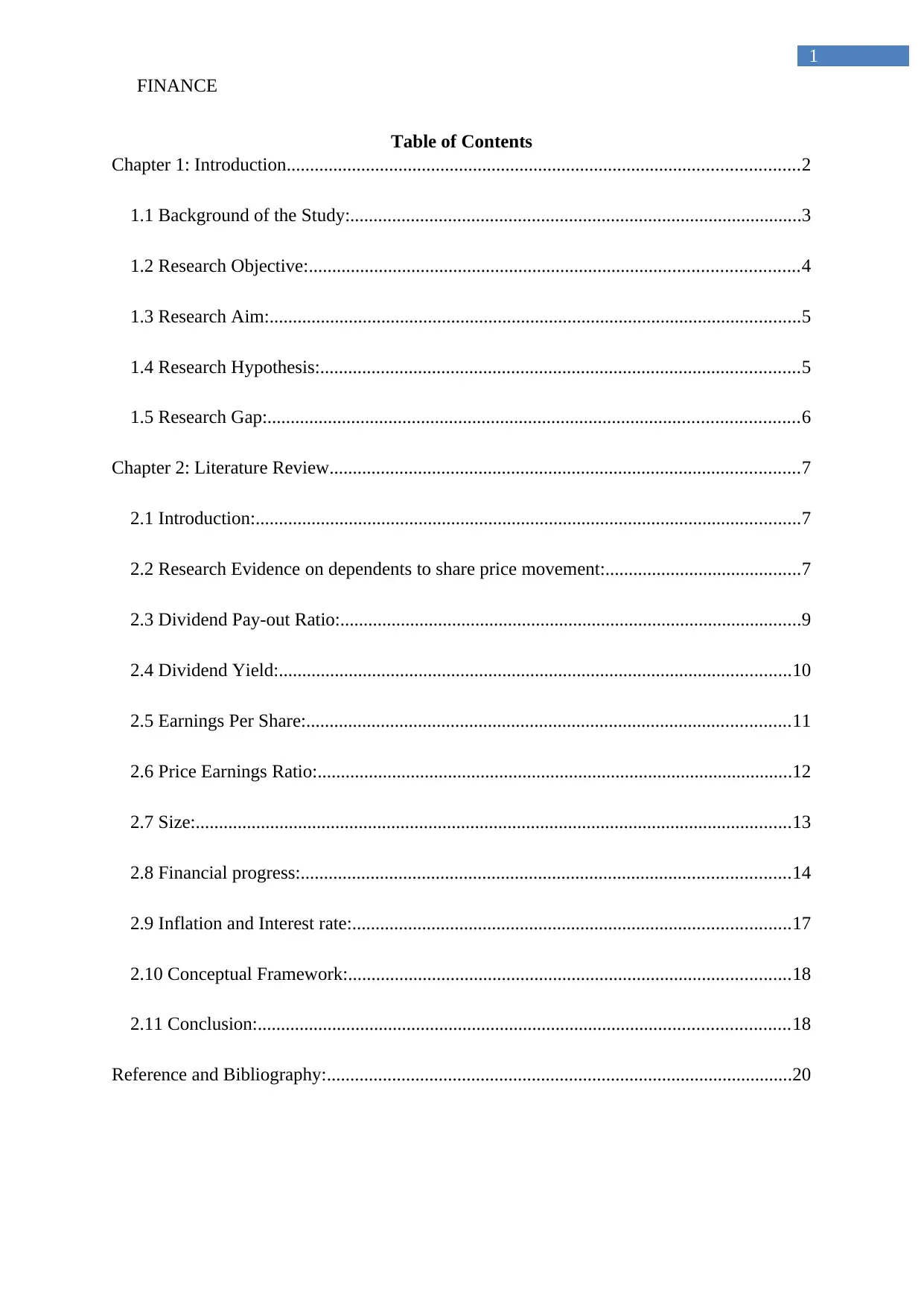
FINANCE
1
Table of Contents
Chapter 1: Introduction..............................................................................................................2
1.1 Background of the Study:.................................................................................................3
1.2 Research Objective:.........................................................................................................4
1.3 Research Aim:..................................................................................................................5
1.4 Research Hypothesis:.......................................................................................................5
1.5 Research Gap:..................................................................................................................6
Chapter 2: Literature Review.....................................................................................................7
2.1 Introduction:.....................................................................................................................7
2.2 Research Evidence on dependents to share price movement:..........................................7
2.3 Dividend Pay-out Ratio:...................................................................................................9
2.4 Dividend Yield:..............................................................................................................10
2.5 Earnings Per Share:........................................................................................................11
2.6 Price Earnings Ratio:......................................................................................................12
2.7 Size:................................................................................................................................13
2.8 Financial progress:.........................................................................................................14
2.9 Inflation and Interest rate:..............................................................................................17
2.10 Conceptual Framework:...............................................................................................18
2.11 Conclusion:..................................................................................................................18
Reference and Bibliography:....................................................................................................20
1
Table of Contents
Chapter 1: Introduction..............................................................................................................2
1.1 Background of the Study:.................................................................................................3
1.2 Research Objective:.........................................................................................................4
1.3 Research Aim:..................................................................................................................5
1.4 Research Hypothesis:.......................................................................................................5
1.5 Research Gap:..................................................................................................................6
Chapter 2: Literature Review.....................................................................................................7
2.1 Introduction:.....................................................................................................................7
2.2 Research Evidence on dependents to share price movement:..........................................7
2.3 Dividend Pay-out Ratio:...................................................................................................9
2.4 Dividend Yield:..............................................................................................................10
2.5 Earnings Per Share:........................................................................................................11
2.6 Price Earnings Ratio:......................................................................................................12
2.7 Size:................................................................................................................................13
2.8 Financial progress:.........................................................................................................14
2.9 Inflation and Interest rate:..............................................................................................17
2.10 Conceptual Framework:...............................................................................................18
2.11 Conclusion:..................................................................................................................18
Reference and Bibliography:....................................................................................................20
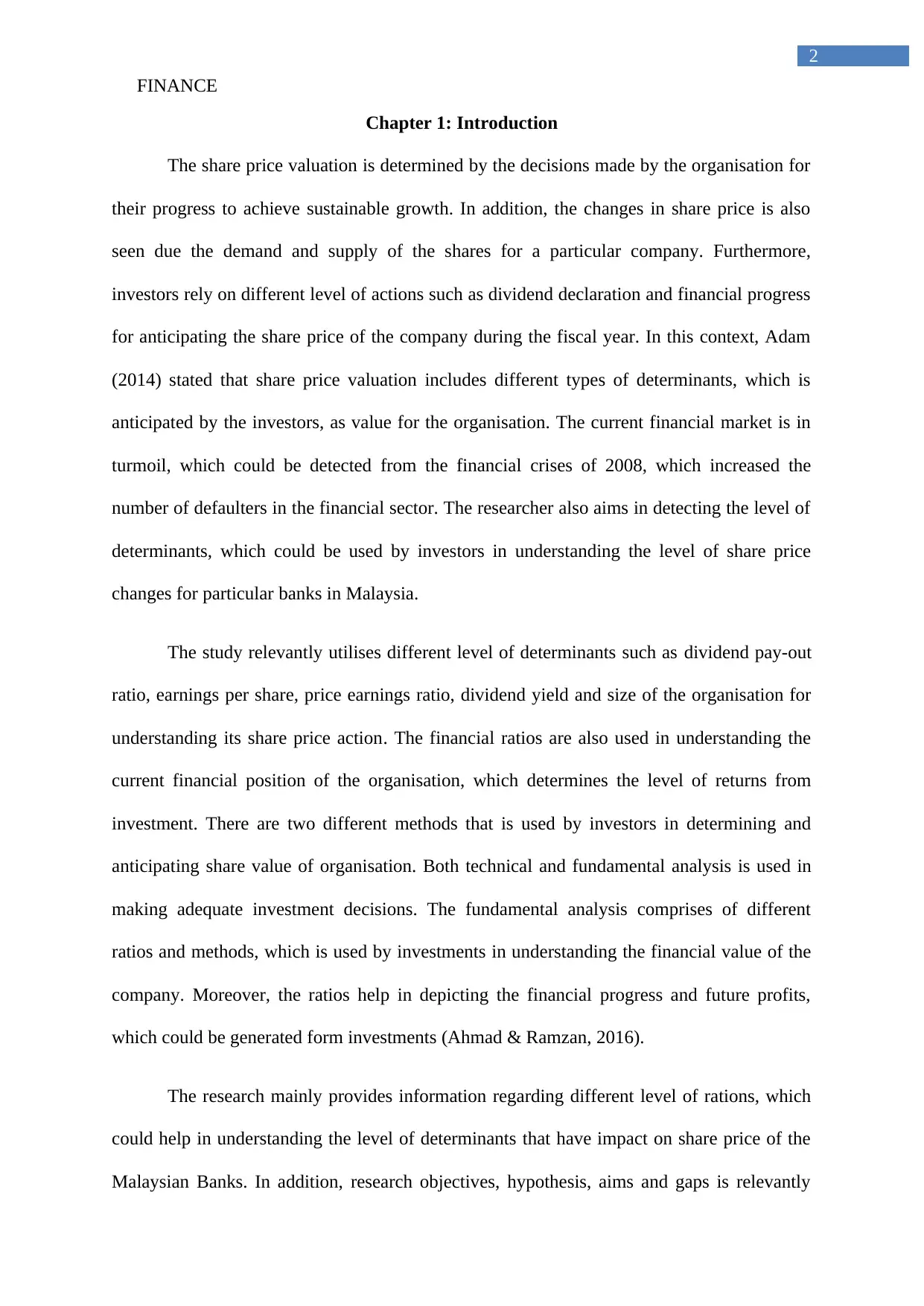
FINANCE
2
Chapter 1: Introduction
The share price valuation is determined by the decisions made by the organisation for
their progress to achieve sustainable growth. In addition, the changes in share price is also
seen due the demand and supply of the shares for a particular company. Furthermore,
investors rely on different level of actions such as dividend declaration and financial progress
for anticipating the share price of the company during the fiscal year. In this context, Adam
(2014) stated that share price valuation includes different types of determinants, which is
anticipated by the investors, as value for the organisation. The current financial market is in
turmoil, which could be detected from the financial crises of 2008, which increased the
number of defaulters in the financial sector. The researcher also aims in detecting the level of
determinants, which could be used by investors in understanding the level of share price
changes for particular banks in Malaysia.
The study relevantly utilises different level of determinants such as dividend pay-out
ratio, earnings per share, price earnings ratio, dividend yield and size of the organisation for
understanding its share price action. The financial ratios are also used in understanding the
current financial position of the organisation, which determines the level of returns from
investment. There are two different methods that is used by investors in determining and
anticipating share value of organisation. Both technical and fundamental analysis is used in
making adequate investment decisions. The fundamental analysis comprises of different
ratios and methods, which is used by investments in understanding the financial value of the
company. Moreover, the ratios help in depicting the financial progress and future profits,
which could be generated form investments (Ahmad & Ramzan, 2016).
The research mainly provides information regarding different level of rations, which
could help in understanding the level of determinants that have impact on share price of the
Malaysian Banks. In addition, research objectives, hypothesis, aims and gaps is relevantly
2
Chapter 1: Introduction
The share price valuation is determined by the decisions made by the organisation for
their progress to achieve sustainable growth. In addition, the changes in share price is also
seen due the demand and supply of the shares for a particular company. Furthermore,
investors rely on different level of actions such as dividend declaration and financial progress
for anticipating the share price of the company during the fiscal year. In this context, Adam
(2014) stated that share price valuation includes different types of determinants, which is
anticipated by the investors, as value for the organisation. The current financial market is in
turmoil, which could be detected from the financial crises of 2008, which increased the
number of defaulters in the financial sector. The researcher also aims in detecting the level of
determinants, which could be used by investors in understanding the level of share price
changes for particular banks in Malaysia.
The study relevantly utilises different level of determinants such as dividend pay-out
ratio, earnings per share, price earnings ratio, dividend yield and size of the organisation for
understanding its share price action. The financial ratios are also used in understanding the
current financial position of the organisation, which determines the level of returns from
investment. There are two different methods that is used by investors in determining and
anticipating share value of organisation. Both technical and fundamental analysis is used in
making adequate investment decisions. The fundamental analysis comprises of different
ratios and methods, which is used by investments in understanding the financial value of the
company. Moreover, the ratios help in depicting the financial progress and future profits,
which could be generated form investments (Ahmad & Ramzan, 2016).
The research mainly provides information regarding different level of rations, which
could help in understanding the level of determinants that have impact on share price of the
Malaysian Banks. In addition, research objectives, hypothesis, aims and gaps is relevantly
⊘ This is a preview!⊘
Do you want full access?
Subscribe today to unlock all pages.

Trusted by 1+ million students worldwide
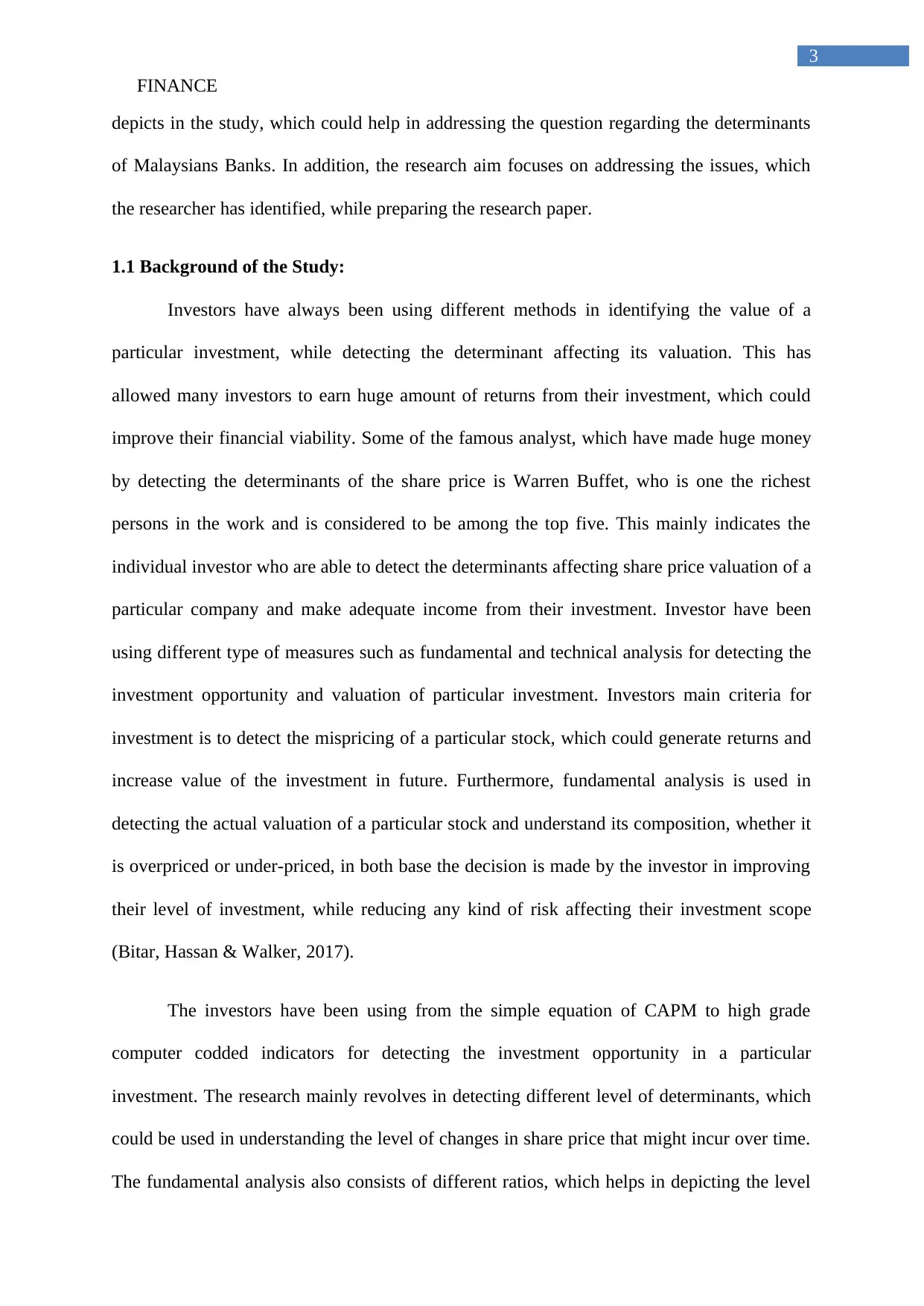
FINANCE
3
depicts in the study, which could help in addressing the question regarding the determinants
of Malaysians Banks. In addition, the research aim focuses on addressing the issues, which
the researcher has identified, while preparing the research paper.
1.1 Background of the Study:
Investors have always been using different methods in identifying the value of a
particular investment, while detecting the determinant affecting its valuation. This has
allowed many investors to earn huge amount of returns from their investment, which could
improve their financial viability. Some of the famous analyst, which have made huge money
by detecting the determinants of the share price is Warren Buffet, who is one the richest
persons in the work and is considered to be among the top five. This mainly indicates the
individual investor who are able to detect the determinants affecting share price valuation of a
particular company and make adequate income from their investment. Investor have been
using different type of measures such as fundamental and technical analysis for detecting the
investment opportunity and valuation of particular investment. Investors main criteria for
investment is to detect the mispricing of a particular stock, which could generate returns and
increase value of the investment in future. Furthermore, fundamental analysis is used in
detecting the actual valuation of a particular stock and understand its composition, whether it
is overpriced or under-priced, in both base the decision is made by the investor in improving
their level of investment, while reducing any kind of risk affecting their investment scope
(Bitar, Hassan & Walker, 2017).
The investors have been using from the simple equation of CAPM to high grade
computer codded indicators for detecting the investment opportunity in a particular
investment. The research mainly revolves in detecting different level of determinants, which
could be used in understanding the level of changes in share price that might incur over time.
The fundamental analysis also consists of different ratios, which helps in depicting the level
3
depicts in the study, which could help in addressing the question regarding the determinants
of Malaysians Banks. In addition, the research aim focuses on addressing the issues, which
the researcher has identified, while preparing the research paper.
1.1 Background of the Study:
Investors have always been using different methods in identifying the value of a
particular investment, while detecting the determinant affecting its valuation. This has
allowed many investors to earn huge amount of returns from their investment, which could
improve their financial viability. Some of the famous analyst, which have made huge money
by detecting the determinants of the share price is Warren Buffet, who is one the richest
persons in the work and is considered to be among the top five. This mainly indicates the
individual investor who are able to detect the determinants affecting share price valuation of a
particular company and make adequate income from their investment. Investor have been
using different type of measures such as fundamental and technical analysis for detecting the
investment opportunity and valuation of particular investment. Investors main criteria for
investment is to detect the mispricing of a particular stock, which could generate returns and
increase value of the investment in future. Furthermore, fundamental analysis is used in
detecting the actual valuation of a particular stock and understand its composition, whether it
is overpriced or under-priced, in both base the decision is made by the investor in improving
their level of investment, while reducing any kind of risk affecting their investment scope
(Bitar, Hassan & Walker, 2017).
The investors have been using from the simple equation of CAPM to high grade
computer codded indicators for detecting the investment opportunity in a particular
investment. The research mainly revolves in detecting different level of determinants, which
could be used in understanding the level of changes in share price that might incur over time.
The fundamental analysis also consists of different ratios, which helps in depicting the level
Paraphrase This Document
Need a fresh take? Get an instant paraphrase of this document with our AI Paraphraser
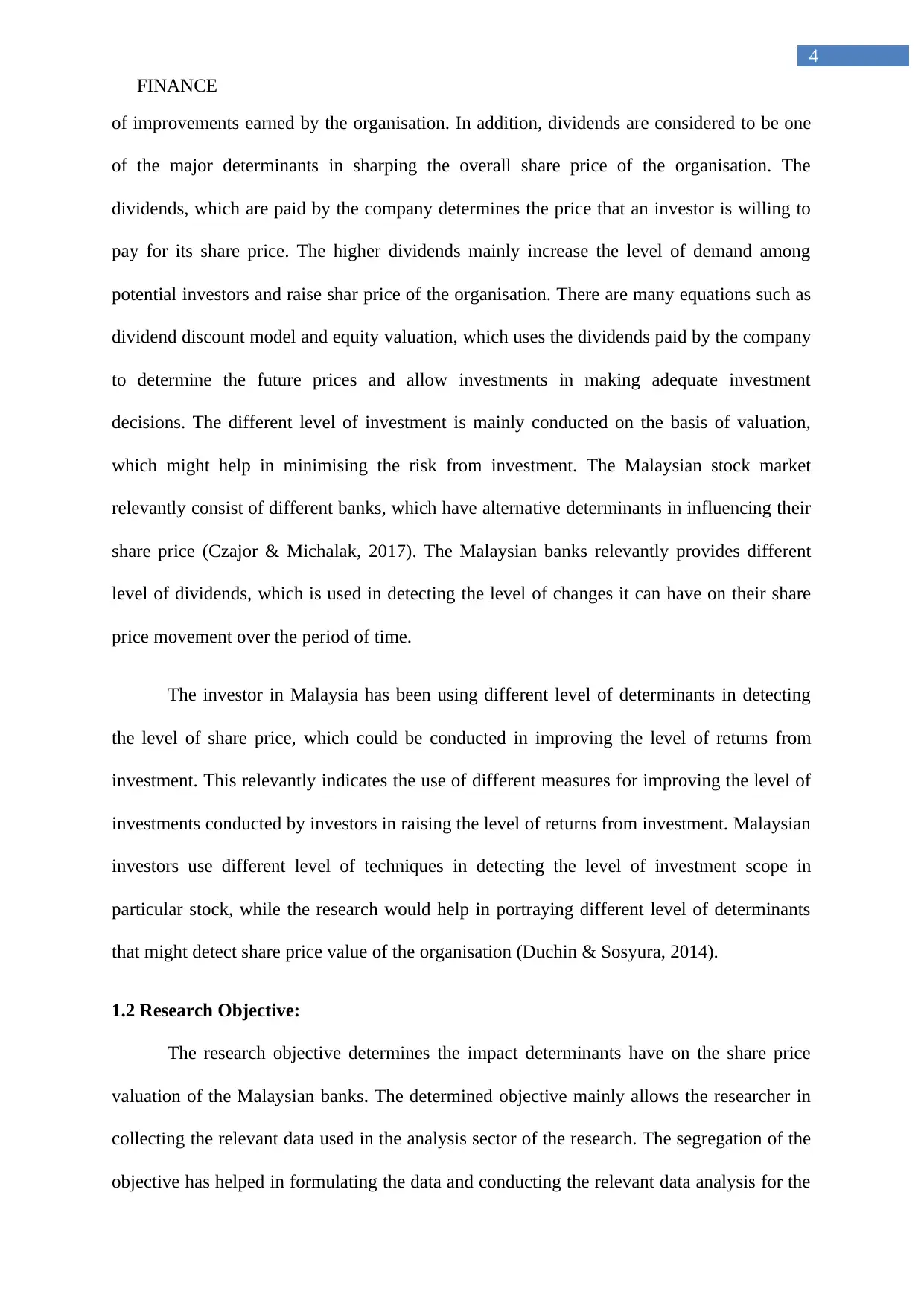
FINANCE
4
of improvements earned by the organisation. In addition, dividends are considered to be one
of the major determinants in sharping the overall share price of the organisation. The
dividends, which are paid by the company determines the price that an investor is willing to
pay for its share price. The higher dividends mainly increase the level of demand among
potential investors and raise shar price of the organisation. There are many equations such as
dividend discount model and equity valuation, which uses the dividends paid by the company
to determine the future prices and allow investments in making adequate investment
decisions. The different level of investment is mainly conducted on the basis of valuation,
which might help in minimising the risk from investment. The Malaysian stock market
relevantly consist of different banks, which have alternative determinants in influencing their
share price (Czajor & Michalak, 2017). The Malaysian banks relevantly provides different
level of dividends, which is used in detecting the level of changes it can have on their share
price movement over the period of time.
The investor in Malaysia has been using different level of determinants in detecting
the level of share price, which could be conducted in improving the level of returns from
investment. This relevantly indicates the use of different measures for improving the level of
investments conducted by investors in raising the level of returns from investment. Malaysian
investors use different level of techniques in detecting the level of investment scope in
particular stock, while the research would help in portraying different level of determinants
that might detect share price value of the organisation (Duchin & Sosyura, 2014).
1.2 Research Objective:
The research objective determines the impact determinants have on the share price
valuation of the Malaysian banks. The determined objective mainly allows the researcher in
collecting the relevant data used in the analysis sector of the research. The segregation of the
objective has helped in formulating the data and conducting the relevant data analysis for the
4
of improvements earned by the organisation. In addition, dividends are considered to be one
of the major determinants in sharping the overall share price of the organisation. The
dividends, which are paid by the company determines the price that an investor is willing to
pay for its share price. The higher dividends mainly increase the level of demand among
potential investors and raise shar price of the organisation. There are many equations such as
dividend discount model and equity valuation, which uses the dividends paid by the company
to determine the future prices and allow investments in making adequate investment
decisions. The different level of investment is mainly conducted on the basis of valuation,
which might help in minimising the risk from investment. The Malaysian stock market
relevantly consist of different banks, which have alternative determinants in influencing their
share price (Czajor & Michalak, 2017). The Malaysian banks relevantly provides different
level of dividends, which is used in detecting the level of changes it can have on their share
price movement over the period of time.
The investor in Malaysia has been using different level of determinants in detecting
the level of share price, which could be conducted in improving the level of returns from
investment. This relevantly indicates the use of different measures for improving the level of
investments conducted by investors in raising the level of returns from investment. Malaysian
investors use different level of techniques in detecting the level of investment scope in
particular stock, while the research would help in portraying different level of determinants
that might detect share price value of the organisation (Duchin & Sosyura, 2014).
1.2 Research Objective:
The research objective determines the impact determinants have on the share price
valuation of the Malaysian banks. The determined objective mainly allows the researcher in
collecting the relevant data used in the analysis sector of the research. The segregation of the
objective has helped in formulating the data and conducting the relevant data analysis for the
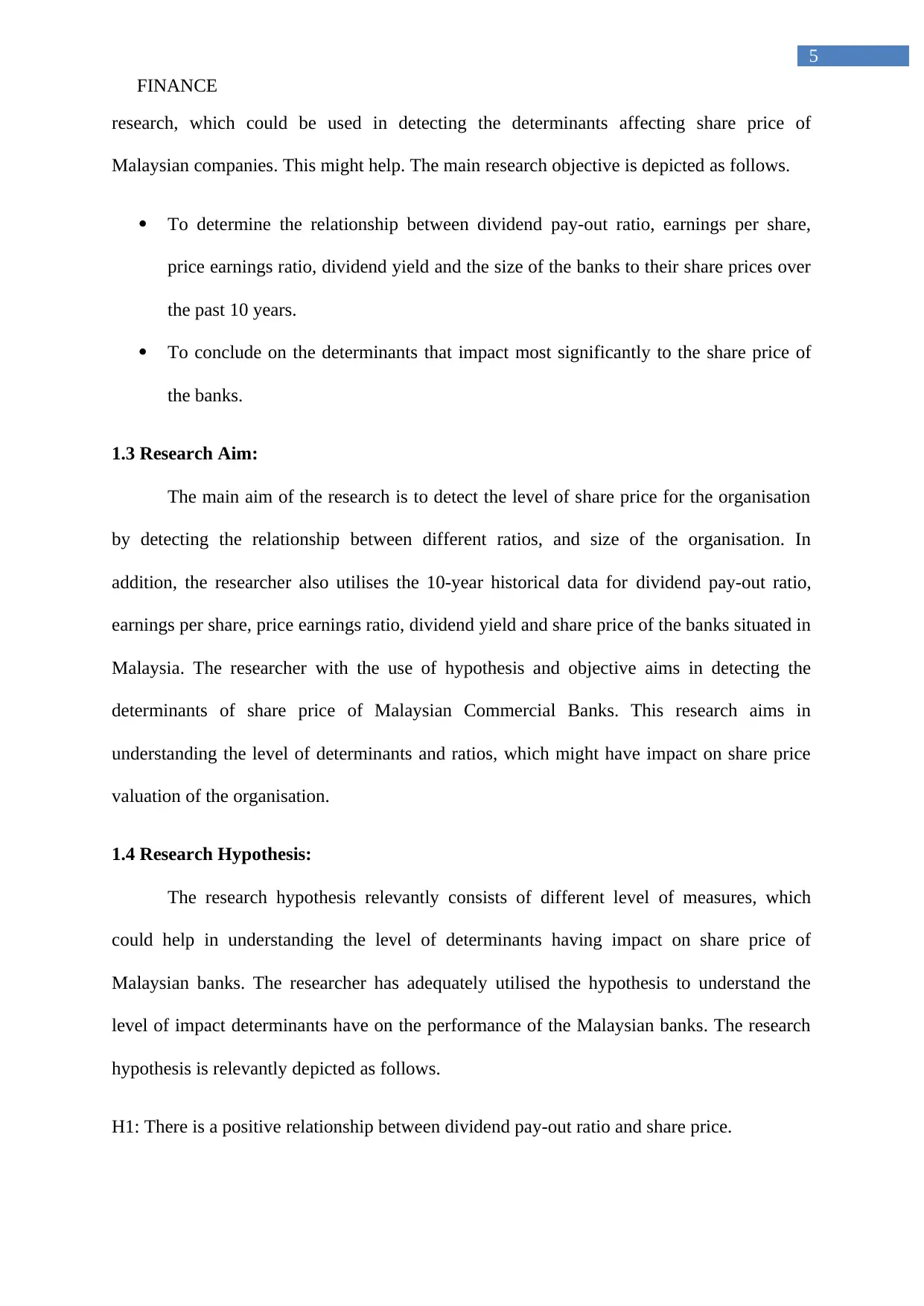
FINANCE
5
research, which could be used in detecting the determinants affecting share price of
Malaysian companies. This might help. The main research objective is depicted as follows.
To determine the relationship between dividend pay-out ratio, earnings per share,
price earnings ratio, dividend yield and the size of the banks to their share prices over
the past 10 years.
To conclude on the determinants that impact most significantly to the share price of
the banks.
1.3 Research Aim:
The main aim of the research is to detect the level of share price for the organisation
by detecting the relationship between different ratios, and size of the organisation. In
addition, the researcher also utilises the 10-year historical data for dividend pay-out ratio,
earnings per share, price earnings ratio, dividend yield and share price of the banks situated in
Malaysia. The researcher with the use of hypothesis and objective aims in detecting the
determinants of share price of Malaysian Commercial Banks. This research aims in
understanding the level of determinants and ratios, which might have impact on share price
valuation of the organisation.
1.4 Research Hypothesis:
The research hypothesis relevantly consists of different level of measures, which
could help in understanding the level of determinants having impact on share price of
Malaysian banks. The researcher has adequately utilised the hypothesis to understand the
level of impact determinants have on the performance of the Malaysian banks. The research
hypothesis is relevantly depicted as follows.
H1: There is a positive relationship between dividend pay-out ratio and share price.
5
research, which could be used in detecting the determinants affecting share price of
Malaysian companies. This might help. The main research objective is depicted as follows.
To determine the relationship between dividend pay-out ratio, earnings per share,
price earnings ratio, dividend yield and the size of the banks to their share prices over
the past 10 years.
To conclude on the determinants that impact most significantly to the share price of
the banks.
1.3 Research Aim:
The main aim of the research is to detect the level of share price for the organisation
by detecting the relationship between different ratios, and size of the organisation. In
addition, the researcher also utilises the 10-year historical data for dividend pay-out ratio,
earnings per share, price earnings ratio, dividend yield and share price of the banks situated in
Malaysia. The researcher with the use of hypothesis and objective aims in detecting the
determinants of share price of Malaysian Commercial Banks. This research aims in
understanding the level of determinants and ratios, which might have impact on share price
valuation of the organisation.
1.4 Research Hypothesis:
The research hypothesis relevantly consists of different level of measures, which
could help in understanding the level of determinants having impact on share price of
Malaysian banks. The researcher has adequately utilised the hypothesis to understand the
level of impact determinants have on the performance of the Malaysian banks. The research
hypothesis is relevantly depicted as follows.
H1: There is a positive relationship between dividend pay-out ratio and share price.
⊘ This is a preview!⊘
Do you want full access?
Subscribe today to unlock all pages.

Trusted by 1+ million students worldwide
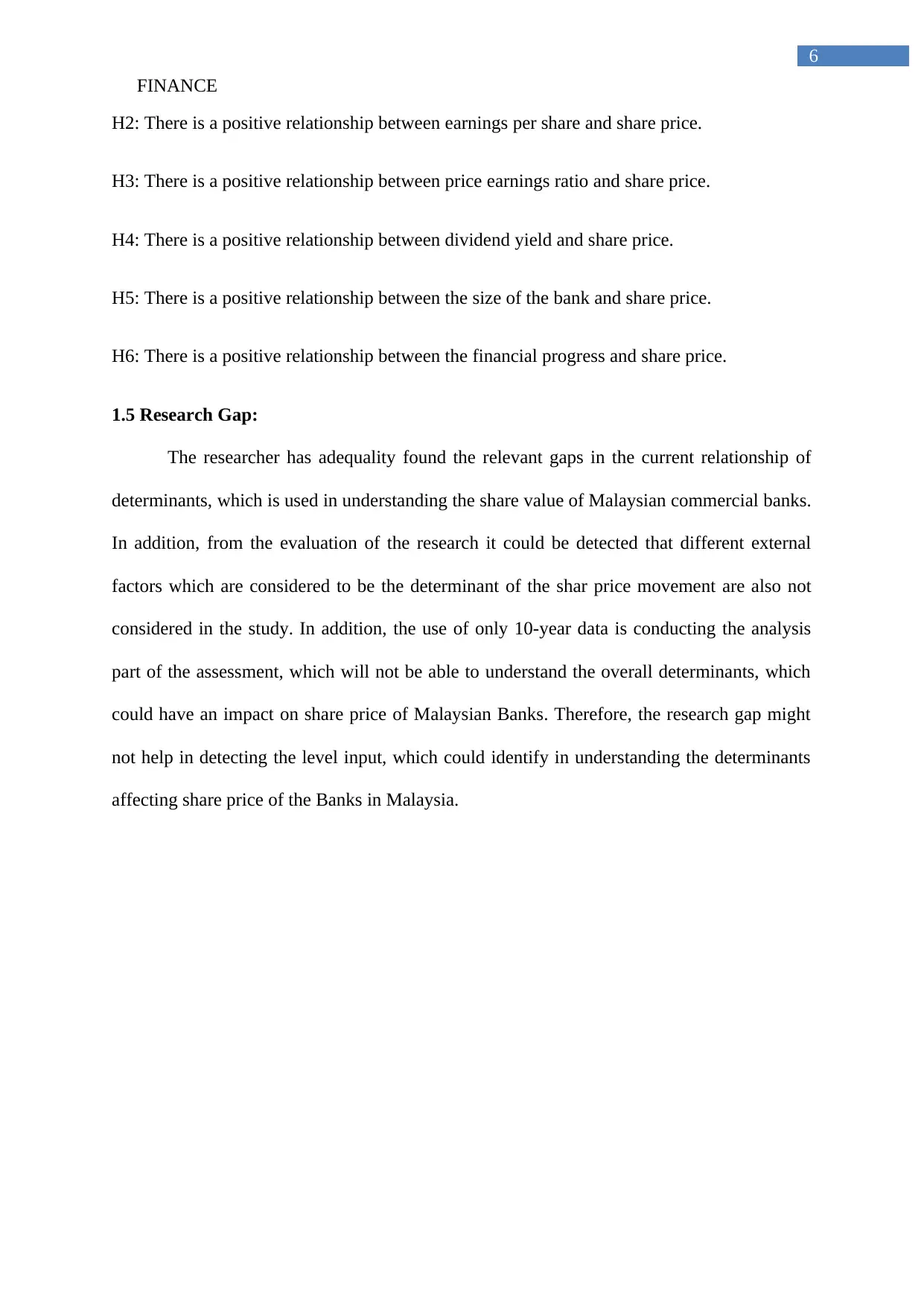
FINANCE
6
H2: There is a positive relationship between earnings per share and share price.
H3: There is a positive relationship between price earnings ratio and share price.
H4: There is a positive relationship between dividend yield and share price.
H5: There is a positive relationship between the size of the bank and share price.
H6: There is a positive relationship between the financial progress and share price.
1.5 Research Gap:
The researcher has adequality found the relevant gaps in the current relationship of
determinants, which is used in understanding the share value of Malaysian commercial banks.
In addition, from the evaluation of the research it could be detected that different external
factors which are considered to be the determinant of the shar price movement are also not
considered in the study. In addition, the use of only 10-year data is conducting the analysis
part of the assessment, which will not be able to understand the overall determinants, which
could have an impact on share price of Malaysian Banks. Therefore, the research gap might
not help in detecting the level input, which could identify in understanding the determinants
affecting share price of the Banks in Malaysia.
6
H2: There is a positive relationship between earnings per share and share price.
H3: There is a positive relationship between price earnings ratio and share price.
H4: There is a positive relationship between dividend yield and share price.
H5: There is a positive relationship between the size of the bank and share price.
H6: There is a positive relationship between the financial progress and share price.
1.5 Research Gap:
The researcher has adequality found the relevant gaps in the current relationship of
determinants, which is used in understanding the share value of Malaysian commercial banks.
In addition, from the evaluation of the research it could be detected that different external
factors which are considered to be the determinant of the shar price movement are also not
considered in the study. In addition, the use of only 10-year data is conducting the analysis
part of the assessment, which will not be able to understand the overall determinants, which
could have an impact on share price of Malaysian Banks. Therefore, the research gap might
not help in detecting the level input, which could identify in understanding the determinants
affecting share price of the Banks in Malaysia.
Paraphrase This Document
Need a fresh take? Get an instant paraphrase of this document with our AI Paraphraser
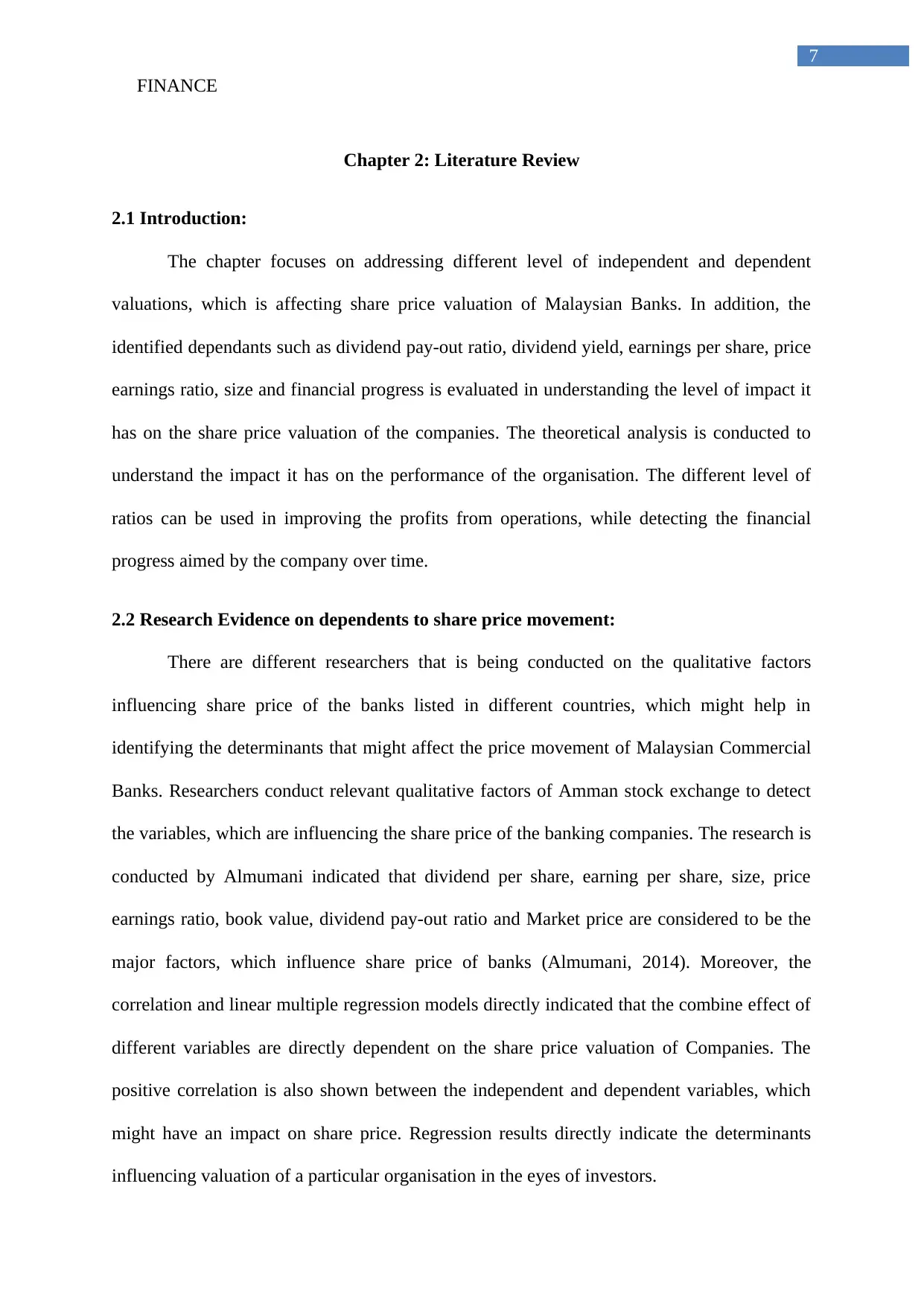
FINANCE
7
Chapter 2: Literature Review
2.1 Introduction:
The chapter focuses on addressing different level of independent and dependent
valuations, which is affecting share price valuation of Malaysian Banks. In addition, the
identified dependants such as dividend pay-out ratio, dividend yield, earnings per share, price
earnings ratio, size and financial progress is evaluated in understanding the level of impact it
has on the share price valuation of the companies. The theoretical analysis is conducted to
understand the impact it has on the performance of the organisation. The different level of
ratios can be used in improving the profits from operations, while detecting the financial
progress aimed by the company over time.
2.2 Research Evidence on dependents to share price movement:
There are different researchers that is being conducted on the qualitative factors
influencing share price of the banks listed in different countries, which might help in
identifying the determinants that might affect the price movement of Malaysian Commercial
Banks. Researchers conduct relevant qualitative factors of Amman stock exchange to detect
the variables, which are influencing the share price of the banking companies. The research is
conducted by Almumani indicated that dividend per share, earning per share, size, price
earnings ratio, book value, dividend pay-out ratio and Market price are considered to be the
major factors, which influence share price of banks (Almumani, 2014). Moreover, the
correlation and linear multiple regression models directly indicated that the combine effect of
different variables are directly dependent on the share price valuation of Companies. The
positive correlation is also shown between the independent and dependent variables, which
might have an impact on share price. Regression results directly indicate the determinants
influencing valuation of a particular organisation in the eyes of investors.
7
Chapter 2: Literature Review
2.1 Introduction:
The chapter focuses on addressing different level of independent and dependent
valuations, which is affecting share price valuation of Malaysian Banks. In addition, the
identified dependants such as dividend pay-out ratio, dividend yield, earnings per share, price
earnings ratio, size and financial progress is evaluated in understanding the level of impact it
has on the share price valuation of the companies. The theoretical analysis is conducted to
understand the impact it has on the performance of the organisation. The different level of
ratios can be used in improving the profits from operations, while detecting the financial
progress aimed by the company over time.
2.2 Research Evidence on dependents to share price movement:
There are different researchers that is being conducted on the qualitative factors
influencing share price of the banks listed in different countries, which might help in
identifying the determinants that might affect the price movement of Malaysian Commercial
Banks. Researchers conduct relevant qualitative factors of Amman stock exchange to detect
the variables, which are influencing the share price of the banking companies. The research is
conducted by Almumani indicated that dividend per share, earning per share, size, price
earnings ratio, book value, dividend pay-out ratio and Market price are considered to be the
major factors, which influence share price of banks (Almumani, 2014). Moreover, the
correlation and linear multiple regression models directly indicated that the combine effect of
different variables are directly dependent on the share price valuation of Companies. The
positive correlation is also shown between the independent and dependent variables, which
might have an impact on share price. Regression results directly indicate the determinants
influencing valuation of a particular organisation in the eyes of investors.
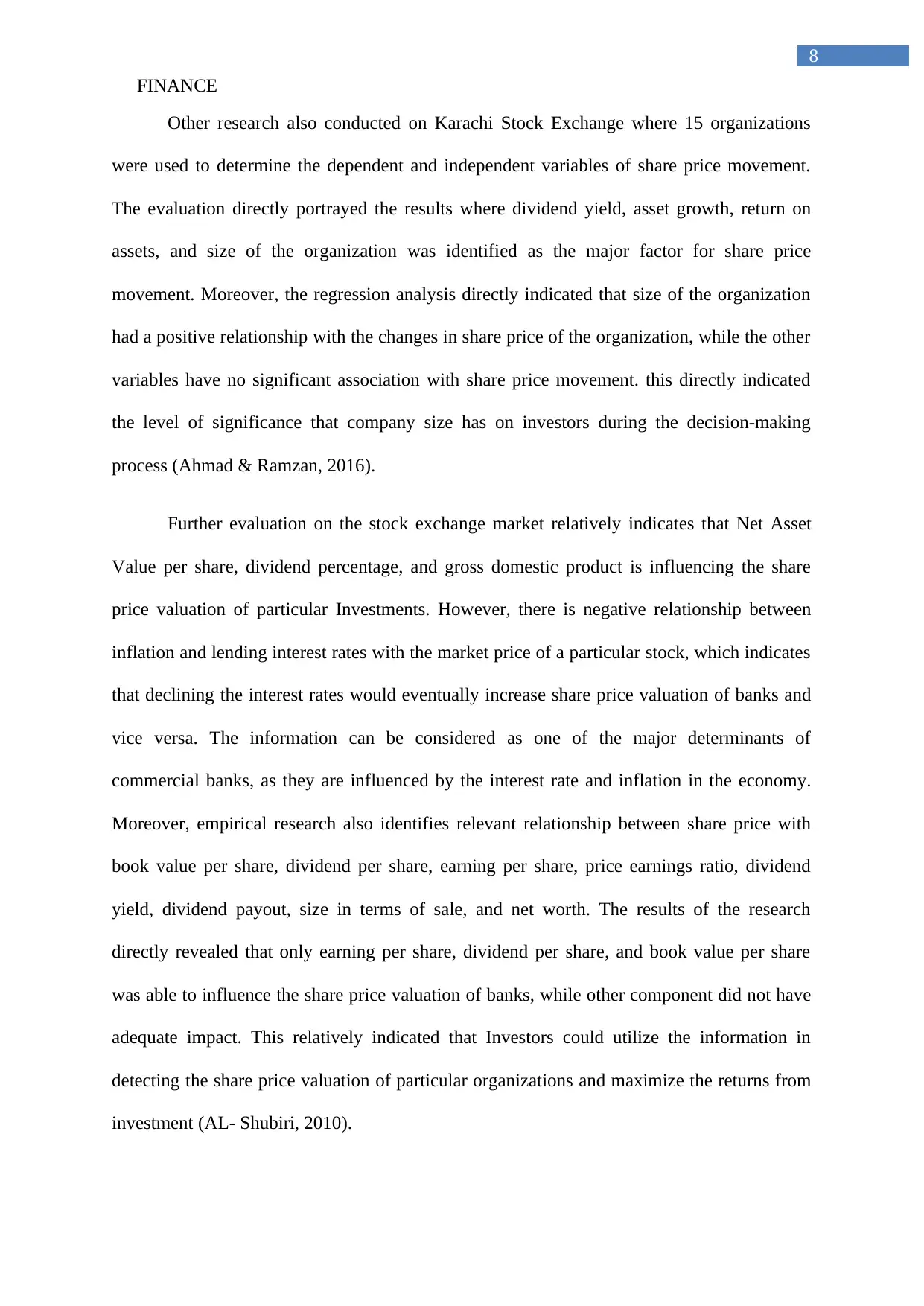
FINANCE
8
Other research also conducted on Karachi Stock Exchange where 15 organizations
were used to determine the dependent and independent variables of share price movement.
The evaluation directly portrayed the results where dividend yield, asset growth, return on
assets, and size of the organization was identified as the major factor for share price
movement. Moreover, the regression analysis directly indicated that size of the organization
had a positive relationship with the changes in share price of the organization, while the other
variables have no significant association with share price movement. this directly indicated
the level of significance that company size has on investors during the decision-making
process (Ahmad & Ramzan, 2016).
Further evaluation on the stock exchange market relatively indicates that Net Asset
Value per share, dividend percentage, and gross domestic product is influencing the share
price valuation of particular Investments. However, there is negative relationship between
inflation and lending interest rates with the market price of a particular stock, which indicates
that declining the interest rates would eventually increase share price valuation of banks and
vice versa. The information can be considered as one of the major determinants of
commercial banks, as they are influenced by the interest rate and inflation in the economy.
Moreover, empirical research also identifies relevant relationship between share price with
book value per share, dividend per share, earning per share, price earnings ratio, dividend
yield, dividend payout, size in terms of sale, and net worth. The results of the research
directly revealed that only earning per share, dividend per share, and book value per share
was able to influence the share price valuation of banks, while other component did not have
adequate impact. This relatively indicated that Investors could utilize the information in
detecting the share price valuation of particular organizations and maximize the returns from
investment (AL- Shubiri, 2010).
8
Other research also conducted on Karachi Stock Exchange where 15 organizations
were used to determine the dependent and independent variables of share price movement.
The evaluation directly portrayed the results where dividend yield, asset growth, return on
assets, and size of the organization was identified as the major factor for share price
movement. Moreover, the regression analysis directly indicated that size of the organization
had a positive relationship with the changes in share price of the organization, while the other
variables have no significant association with share price movement. this directly indicated
the level of significance that company size has on investors during the decision-making
process (Ahmad & Ramzan, 2016).
Further evaluation on the stock exchange market relatively indicates that Net Asset
Value per share, dividend percentage, and gross domestic product is influencing the share
price valuation of particular Investments. However, there is negative relationship between
inflation and lending interest rates with the market price of a particular stock, which indicates
that declining the interest rates would eventually increase share price valuation of banks and
vice versa. The information can be considered as one of the major determinants of
commercial banks, as they are influenced by the interest rate and inflation in the economy.
Moreover, empirical research also identifies relevant relationship between share price with
book value per share, dividend per share, earning per share, price earnings ratio, dividend
yield, dividend payout, size in terms of sale, and net worth. The results of the research
directly revealed that only earning per share, dividend per share, and book value per share
was able to influence the share price valuation of banks, while other component did not have
adequate impact. This relatively indicated that Investors could utilize the information in
detecting the share price valuation of particular organizations and maximize the returns from
investment (AL- Shubiri, 2010).
⊘ This is a preview!⊘
Do you want full access?
Subscribe today to unlock all pages.

Trusted by 1+ million students worldwide
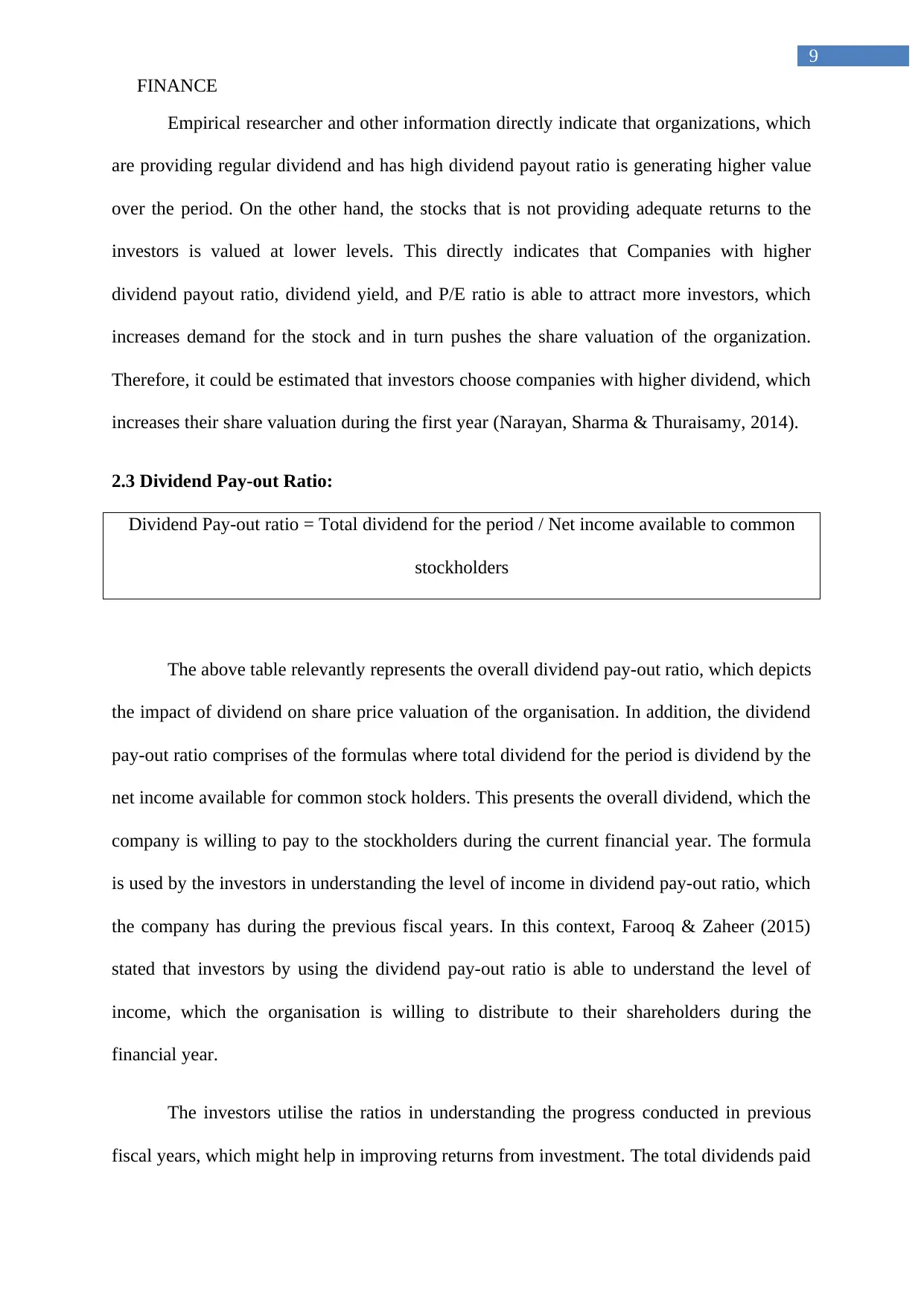
FINANCE
9
Empirical researcher and other information directly indicate that organizations, which
are providing regular dividend and has high dividend payout ratio is generating higher value
over the period. On the other hand, the stocks that is not providing adequate returns to the
investors is valued at lower levels. This directly indicates that Companies with higher
dividend payout ratio, dividend yield, and P/E ratio is able to attract more investors, which
increases demand for the stock and in turn pushes the share valuation of the organization.
Therefore, it could be estimated that investors choose companies with higher dividend, which
increases their share valuation during the first year (Narayan, Sharma & Thuraisamy, 2014).
2.3 Dividend Pay-out Ratio:
Dividend Pay-out ratio = Total dividend for the period / Net income available to common
stockholders
The above table relevantly represents the overall dividend pay-out ratio, which depicts
the impact of dividend on share price valuation of the organisation. In addition, the dividend
pay-out ratio comprises of the formulas where total dividend for the period is dividend by the
net income available for common stock holders. This presents the overall dividend, which the
company is willing to pay to the stockholders during the current financial year. The formula
is used by the investors in understanding the level of income in dividend pay-out ratio, which
the company has during the previous fiscal years. In this context, Farooq & Zaheer (2015)
stated that investors by using the dividend pay-out ratio is able to understand the level of
income, which the organisation is willing to distribute to their shareholders during the
financial year.
The investors utilise the ratios in understanding the progress conducted in previous
fiscal years, which might help in improving returns from investment. The total dividends paid
9
Empirical researcher and other information directly indicate that organizations, which
are providing regular dividend and has high dividend payout ratio is generating higher value
over the period. On the other hand, the stocks that is not providing adequate returns to the
investors is valued at lower levels. This directly indicates that Companies with higher
dividend payout ratio, dividend yield, and P/E ratio is able to attract more investors, which
increases demand for the stock and in turn pushes the share valuation of the organization.
Therefore, it could be estimated that investors choose companies with higher dividend, which
increases their share valuation during the first year (Narayan, Sharma & Thuraisamy, 2014).
2.3 Dividend Pay-out Ratio:
Dividend Pay-out ratio = Total dividend for the period / Net income available to common
stockholders
The above table relevantly represents the overall dividend pay-out ratio, which depicts
the impact of dividend on share price valuation of the organisation. In addition, the dividend
pay-out ratio comprises of the formulas where total dividend for the period is dividend by the
net income available for common stock holders. This presents the overall dividend, which the
company is willing to pay to the stockholders during the current financial year. The formula
is used by the investors in understanding the level of income in dividend pay-out ratio, which
the company has during the previous fiscal years. In this context, Farooq & Zaheer (2015)
stated that investors by using the dividend pay-out ratio is able to understand the level of
income, which the organisation is willing to distribute to their shareholders during the
financial year.
The investors utilise the ratios in understanding the progress conducted in previous
fiscal years, which might help in improving returns from investment. The total dividends paid
Paraphrase This Document
Need a fresh take? Get an instant paraphrase of this document with our AI Paraphraser
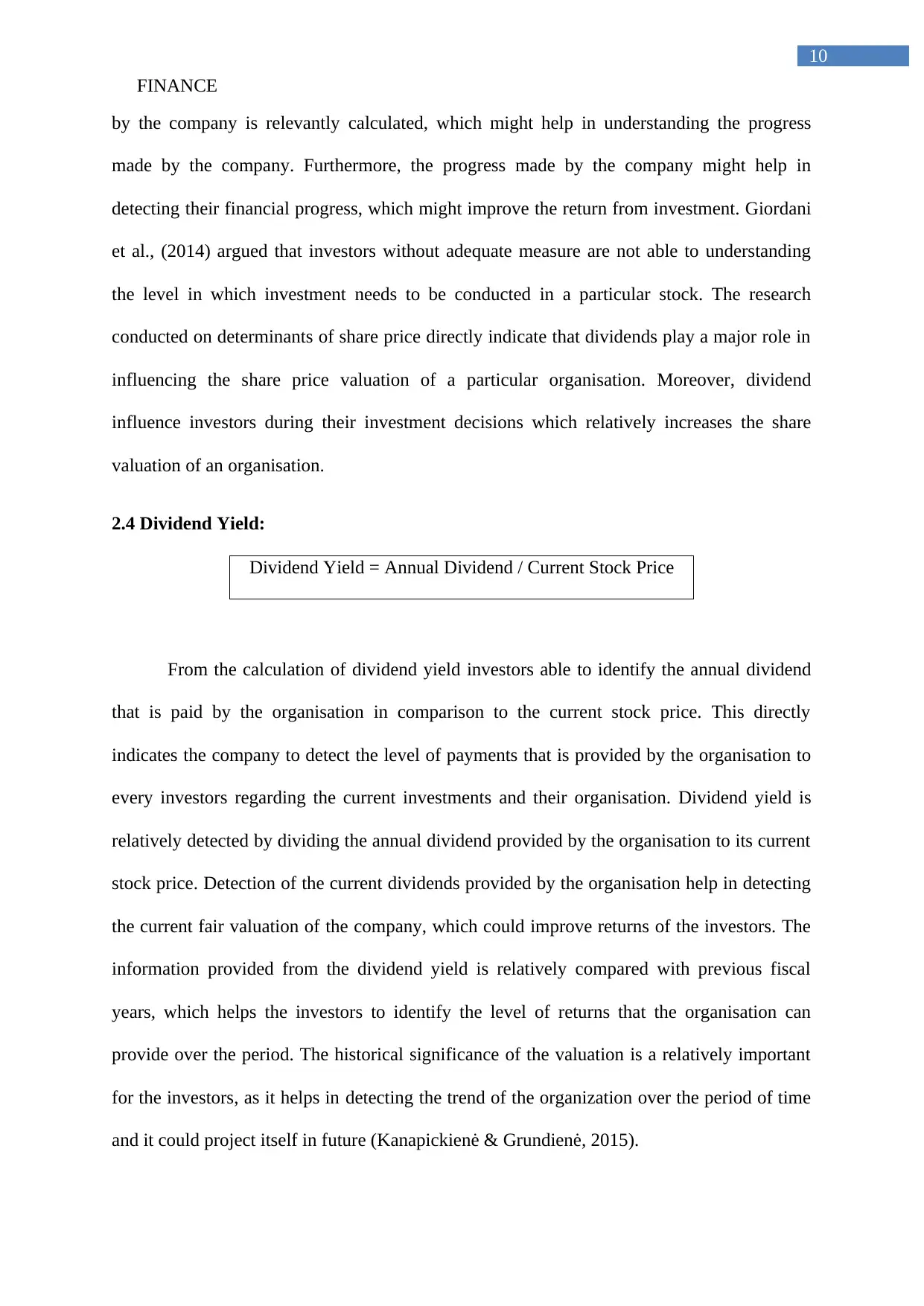
FINANCE
10
by the company is relevantly calculated, which might help in understanding the progress
made by the company. Furthermore, the progress made by the company might help in
detecting their financial progress, which might improve the return from investment. Giordani
et al., (2014) argued that investors without adequate measure are not able to understanding
the level in which investment needs to be conducted in a particular stock. The research
conducted on determinants of share price directly indicate that dividends play a major role in
influencing the share price valuation of a particular organisation. Moreover, dividend
influence investors during their investment decisions which relatively increases the share
valuation of an organisation.
2.4 Dividend Yield:
Dividend Yield = Annual Dividend / Current Stock Price
From the calculation of dividend yield investors able to identify the annual dividend
that is paid by the organisation in comparison to the current stock price. This directly
indicates the company to detect the level of payments that is provided by the organisation to
every investors regarding the current investments and their organisation. Dividend yield is
relatively detected by dividing the annual dividend provided by the organisation to its current
stock price. Detection of the current dividends provided by the organisation help in detecting
the current fair valuation of the company, which could improve returns of the investors. The
information provided from the dividend yield is relatively compared with previous fiscal
years, which helps the investors to identify the level of returns that the organisation can
provide over the period. The historical significance of the valuation is a relatively important
for the investors, as it helps in detecting the trend of the organization over the period of time
and it could project itself in future (Kanapickienė & Grundienė, 2015).
10
by the company is relevantly calculated, which might help in understanding the progress
made by the company. Furthermore, the progress made by the company might help in
detecting their financial progress, which might improve the return from investment. Giordani
et al., (2014) argued that investors without adequate measure are not able to understanding
the level in which investment needs to be conducted in a particular stock. The research
conducted on determinants of share price directly indicate that dividends play a major role in
influencing the share price valuation of a particular organisation. Moreover, dividend
influence investors during their investment decisions which relatively increases the share
valuation of an organisation.
2.4 Dividend Yield:
Dividend Yield = Annual Dividend / Current Stock Price
From the calculation of dividend yield investors able to identify the annual dividend
that is paid by the organisation in comparison to the current stock price. This directly
indicates the company to detect the level of payments that is provided by the organisation to
every investors regarding the current investments and their organisation. Dividend yield is
relatively detected by dividing the annual dividend provided by the organisation to its current
stock price. Detection of the current dividends provided by the organisation help in detecting
the current fair valuation of the company, which could improve returns of the investors. The
information provided from the dividend yield is relatively compared with previous fiscal
years, which helps the investors to identify the level of returns that the organisation can
provide over the period. The historical significance of the valuation is a relatively important
for the investors, as it helps in detecting the trend of the organization over the period of time
and it could project itself in future (Kanapickienė & Grundienė, 2015).
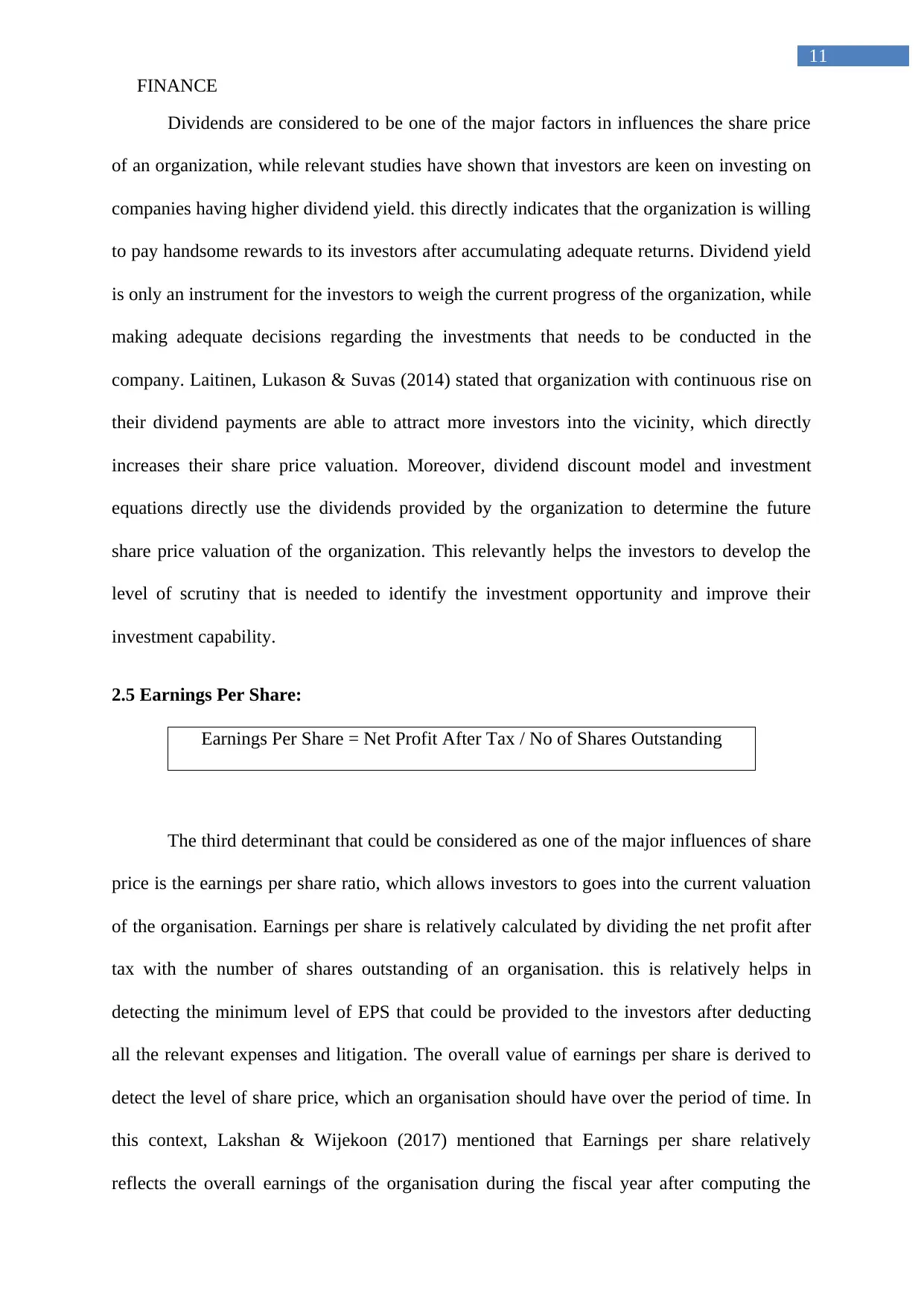
FINANCE
11
Dividends are considered to be one of the major factors in influences the share price
of an organization, while relevant studies have shown that investors are keen on investing on
companies having higher dividend yield. this directly indicates that the organization is willing
to pay handsome rewards to its investors after accumulating adequate returns. Dividend yield
is only an instrument for the investors to weigh the current progress of the organization, while
making adequate decisions regarding the investments that needs to be conducted in the
company. Laitinen, Lukason & Suvas (2014) stated that organization with continuous rise on
their dividend payments are able to attract more investors into the vicinity, which directly
increases their share price valuation. Moreover, dividend discount model and investment
equations directly use the dividends provided by the organization to determine the future
share price valuation of the organization. This relevantly helps the investors to develop the
level of scrutiny that is needed to identify the investment opportunity and improve their
investment capability.
2.5 Earnings Per Share:
Earnings Per Share = Net Profit After Tax / No of Shares Outstanding
The third determinant that could be considered as one of the major influences of share
price is the earnings per share ratio, which allows investors to goes into the current valuation
of the organisation. Earnings per share is relatively calculated by dividing the net profit after
tax with the number of shares outstanding of an organisation. this is relatively helps in
detecting the minimum level of EPS that could be provided to the investors after deducting
all the relevant expenses and litigation. The overall value of earnings per share is derived to
detect the level of share price, which an organisation should have over the period of time. In
this context, Lakshan & Wijekoon (2017) mentioned that Earnings per share relatively
reflects the overall earnings of the organisation during the fiscal year after computing the
11
Dividends are considered to be one of the major factors in influences the share price
of an organization, while relevant studies have shown that investors are keen on investing on
companies having higher dividend yield. this directly indicates that the organization is willing
to pay handsome rewards to its investors after accumulating adequate returns. Dividend yield
is only an instrument for the investors to weigh the current progress of the organization, while
making adequate decisions regarding the investments that needs to be conducted in the
company. Laitinen, Lukason & Suvas (2014) stated that organization with continuous rise on
their dividend payments are able to attract more investors into the vicinity, which directly
increases their share price valuation. Moreover, dividend discount model and investment
equations directly use the dividends provided by the organization to determine the future
share price valuation of the organization. This relevantly helps the investors to develop the
level of scrutiny that is needed to identify the investment opportunity and improve their
investment capability.
2.5 Earnings Per Share:
Earnings Per Share = Net Profit After Tax / No of Shares Outstanding
The third determinant that could be considered as one of the major influences of share
price is the earnings per share ratio, which allows investors to goes into the current valuation
of the organisation. Earnings per share is relatively calculated by dividing the net profit after
tax with the number of shares outstanding of an organisation. this is relatively helps in
detecting the minimum level of EPS that could be provided to the investors after deducting
all the relevant expenses and litigation. The overall value of earnings per share is derived to
detect the level of share price, which an organisation should have over the period of time. In
this context, Lakshan & Wijekoon (2017) mentioned that Earnings per share relatively
reflects the overall earnings of the organisation during the fiscal year after computing the
⊘ This is a preview!⊘
Do you want full access?
Subscribe today to unlock all pages.

Trusted by 1+ million students worldwide
1 out of 24
Related Documents
Your All-in-One AI-Powered Toolkit for Academic Success.
+13062052269
info@desklib.com
Available 24*7 on WhatsApp / Email
![[object Object]](/_next/static/media/star-bottom.7253800d.svg)
Unlock your academic potential
Copyright © 2020–2025 A2Z Services. All Rights Reserved. Developed and managed by ZUCOL.




